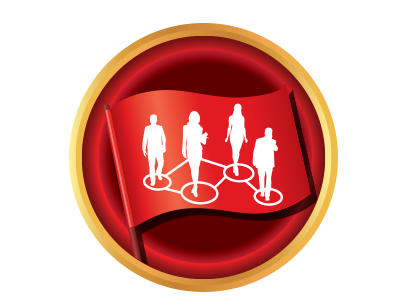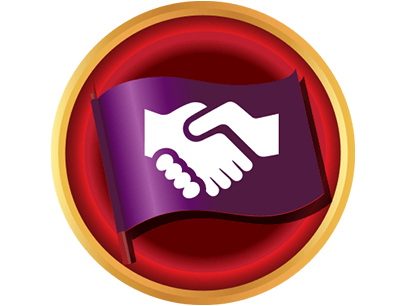Two years ago, Toastmasters launched the Pathways learning experience, the most ambitious education program in the organization’s history. Since then, existing members have been able to work in either Pathways or the traditional education program—or both—during a transition period.
But that period ends less than a year from now—June 30, 2020—after which members can only work in Pathways. Are you ready? If not—or even if you are—now is the perfect time to review the basics of this expansive and innovative program. Such information, as well as resources, statistics and answers to common questions, can be found on the following pages. Think of it as Pathways 101.
Let’s start with the obvious question: Why is the organization switching to Pathways? For many reasons—one of them being that it was time for Toastmasters to modernize the education program. Pathways is an online curriculum, providing users with flexibility; members can work on projects whenever and wherever they want. Participants have greater access to educational materials than in the traditional program.
Although purchasing Pathways content in print is an option, most members who enroll choose the online system, gaining access to videos, interactive content, tutorials, and other tools and resources. Members learn skills in Pathways that are transferable outside Toastmasters club meetings, as many participants can attest.
“My favorite part of the program has been the huge range of new, real-world, relevant projects available, which I’ve been able to integrate into my life and goals outside Toastmasters,” says Mark Snow, DTM, a member of three clubs in Queensland, Australia. Several Pathways projects, he adds, helped him in his career as a government financial analyst.
James Wantz, DTM, of Beaverton, Oregon, says he has honed his leadership and networking skills in Pathways, which has helped him in his work as a 3-D computer detailer for a structural steel company. “I am now the go-to person in the office to meet with the clients and discuss projects,” he says.
To hear what members say about their Pathways experience, watch videos of Snow, Wantz and others.
The Online Experience
Ever since Pathways launched, members have offered extensive feedback about the program, mostly expressing praise and enthusiasm for its content and innovations, but also suggesting improvements to the online navigation. The online gateway to Pathways is called Base Camp, where members find everything needed to navigate the program. This is where participants work on projects, track their progress and connect with club members.
The input from Base Camp users about online navigation is closely reviewed by the Pathways team at Toastmasters World Headquarters. Addressing members’ concerns is part of an extensive effort to improve the digital experience. To that end, World Headquarters last year established the Summit Team, composed of members from different departments. The group has gathered feedback from members, and its first project was redesigning and enhancing the online Navigator, which helps new members better understand Base Camp. It is currently working on improving the online navigation experience.
Club officers, particularly the vice president education, play a critical role in helping members become comfortable with Base Camp. Officers can lead the way by sharing their knowledge and experience. One helpful strategy is holding club meetings—or sessions within the meetings—dedicated to providing information and answering questions about Pathways and Base Camp, and getting members enrolled in the program if they aren’t already.
See some questions and answers about Base Camp in the FAQ.
How the Program Works
Learning paths form the foundation of the Pathways structure. Members work in the path best suited to helping them achieve personal and professional goals. In this way, Pathways is a customized learning experience, tailored to specific needs.
This reflects the progressive concepts in instructional design used by the Pathways development team. In designing the program, developers drew on the most current research in adult learning, focusing on key principles:
- Internal motivation is the driving force to learn. Adult education needs to be self-directed (thus, the customized nature of Pathways).
- Hands-on, experiential learning is vital, as is a focus on critical thinking. Wherever possible, concrete experiences are built into Pathways to emphasize the learn-by-doing approach fundamental to Toastmasters’ education programs over the years. Example: For a project on how a speaker can manage a difficult audience, club members behave like disruptive audience members so the member doing the project can practice handling that situation.
- To learn best, adults want to know why they need to learn something. What is the value to them? In Pathways, you apply what you learn, doing something tangible with your newfound knowledge. In the High Performance Leadership project, for example, you apply your leadership and planning skills by guiding a team through a project, from conception to completion.
The Pathways structure includes paths, projects and different levels of skill-building.
Paths:
Eleven specialized paths are available. Titles include Presentation Mastery, Dynamic Leadership, Innovative Planning and Persuasive Influence. The content is challenging and robust—you can develop more than 300 competencies, such as blogging, answering questions effectively, speaking about personal strengths and weaknesses, and leading with resourcefulness and flexibility.
From March through July of this year, the Toastmaster magazine featured articles about the following paths: Presentation Mastery, Innovative Planning, Dynamic Leadership, Strategic Relationships and Motivational Strategies, respectively. (Visit the magazine archive on the Toastmasters website to read these articles and find accompanying videos.)
Projects:
Every path features a minimum of 14 projects. Each project includes at least one speech. Projects include many different topics, from understanding your own communication style to learning leadership tips to discovering how best to connect with others. To finish a path, you must complete a combination of 10 required projects and four electives (although you have the option to take as many electives as you want).“Pathways is designed to keep club meetings at the center of your Toastmasters experience.”
Levels:
Each path has five levels in which you complete projects and build on what you learned in the previous level.- Level 1: Mastering Fundamentals
- Level 2: Learning Your Style
- Level 3: Increasing Knowledge
- Level 4: Building Skills
- Level 5: Demonstrating Expertise
Evaluations:
Pathways speech evaluations are more comprehensive and uniform than in the traditional education program. The criteria is standardized: When members give a speech, they are evaluated by the same objective standards. For example, here’s criteria for assessing what might be missing in a speech: “The purpose was not evident. Content lacked organization. The majority of ideas were unsupported by additional information or details.” Other criteria reflect the success of a speech: “The member spoke clearly, and vocabulary was descriptive, accurate and engaging. The member manipulated tone, speed and volume to emphasize important ideas and hold the listener’s attention.”The evaluation guidelines lead to specific and detailed feedback, and the standardized criteria help increase the consistency of evaluations for all members.
Translations:
One of Pathways’ greatest attributes is the availability of material in languages other than English. Pathways content is translated in Arabic, French, German, Japanese, Portuguese, Spanish, and Simplified and Traditional Chinese—and will soon be available in Tamil and Korean as well.Toastmasters around the world volunteer their efforts to serve on translation review teams, who ensure that all Pathways translations are accurate and authentic to the local culture.
If you haven’t already started working in Pathways, start now. That is the best way to learn about the program. Even if you want to complete certain goals in the traditional program, begin working in Pathways as well.
If you are confused or having problems in Base Camp, ask questions. Club officers and fellow members are happy to help. In addition, many useful resources are available on the Pathways webpage on the Toastmasters website.
Persevere in Pathways, and your efforts will pay off. You’ll be rewarded with an engaging learning experience that helps you develop the skills you need to thrive.
Are you ready to uncover the power of Pathways with friends and colleagues? Share the video below for real examples of how the Pathways learning experience has helped transform members' careers.
Paul Sterman is senior editor, executive and editorial content, for Toastmasters International. Reach him at psterman@toastmasters.org.
Related Articles

Toastmasters News
The Path to Motivational Strategies

Club Experience



 Previous
Previous
 You've Got Questions ... We've Got Answers
You've Got Questions ... We've Got Answers
 Previous Article
Previous Article